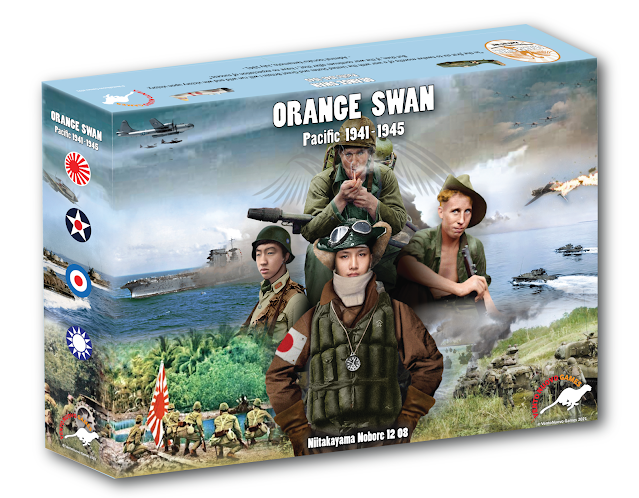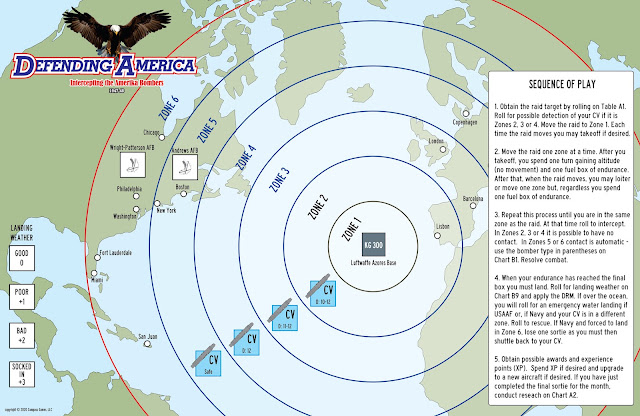Orange Swan
Pacific 1941 - 1945
by
VentoNuovo Games
The Pacific Theater of War is normally thought of as starting on December 7th 1941. In actuality Japan and China had been fighting since 1937. Japan was allied with Italy and Germany, even though they were not at war with the Allies. The Japanese Armed Forces were split between the Army and Navy factions. This split was so cavernous that assassinations of generals and admirals had been contemplated, and in fact carried out at times. The Army wanted to 'Strike North' and attack the Soviet Union. The Navy wanted to strike south and attack the Western Allies colonies. There were separate arguments inside both branches over the efficacy of both plans. In fact, Admiral Yamamoto was put in charge of the Combined Fleet to remove him from Japan and the chance for his assassination. This was because of his outspoken thoughts against a war with the United States. He had been an attache there and knew the size and capabilities of the US in a war. Japan's economic might paled before the US even in peacetime. Once the US was put on a war footing it was a foregone conclusion to Yamamoto. In hindsight, it is possible that even had Japan not done well with an invasion of the Soviet Union (they had fared poorly against Soviet troops in 1939). They would however, had kept the Asiatic forces of the Soviet Union in place and they would not be allowed to reinforce the Soviet troops in front of Moscow, possibly leading to a German victory. Because of the aggression of Japan against China, the Western Allies had placed many embargos on items desperately needed by the Japanese Armed Forces. The biggest problem for Japan was an embargo on imported oil. This, in the end, forced the Japanese government to finally side with the Navy to attack south toward the Indonesian oil fields. In actuality Japan was to get precious few barrels of oil from Indonesia. Between the effective Allied destruction of the wells, and the US submarine war on Japanese transports, very little ever saw Japan. Enough with the backdrop of the game. Now we must look at the name the designer has given it.
.jpg) |
| A battle about to take place |
VentoNuovo Games released a game last year called 'Black Swan'. This encompasses the Second World War in the European and African Theaters. The name is described thusly in the Black Swan Rule Book:
"Since antiquity, some have known this as “The Black Swan.” It is the rare and unlooked for event, something that is entirely unexpected and presages abrupt reversal.
In martial terms, The Black Swan symbolizes the unravelling of apparent certainty, together with man’s desire to contrive notions of opportunity, or excuses for defeat, whenever he dares play with the volatile flames of ambition."
The moniker 'Orange Swan' is because of the above, and the fact that the United States' plan for a war against Japan was 'Plan Orange'.
To those hex and counter behemoths that I was once so enamored with, this game seems rather simple. That is in fact a complete falsehood. While Orange Swan does not have a Rules Manual as thick as a phone book, that does not mean it is a simple game. This game will take all of your wits and thinking ahead to work out a coherent strategy to win. You not only have to win battles, but you also have to think about supply lines as well. Effectively you are put into the shoes of the Chief of Staff of both sides. As the US you have to try and blunt Japan's sword in the early days so that you do not have to win the entire Pacific back from them. You need to hang on and wait until the US starts flooding the Pacific Ocean with material, men, and ships. So, you have to choose your early fights with Japan with care. As the Allied player you cannot afford to lose China and or India. Japan is not only able to attack you on the seas but also in Asia proper. The Japanese player will never be as strong as he is at the start (unless by some miracle he never loses a battle up to 1943). The player has to decide how much is too much and will he also suffer from 'Victory Disease'? Does he try to conquer China, India, or concentrate on the Pacific? The one thing that the Japanese player has on his side is that at the beginning the Allied player has to dance to his tune. He always has to keep at the back of his mind that the Allied player can also Island, or in this case Area, hop. This would leave the Japanese forces hanging on the vine.
The game can be won in several different ways.
Tokyo is enemy controlled: Allied Victory
Atom Bomb Event: Allied Victory
Japan controls 7 Strategic Areas or Japan has a production of 75: Axis Victory
If at the end of a year in the Campaign game, Japan has a Strategic Power of 6 it wins a Strategic Victory.
If at the end of the year Japan has an Economic Power equal or greater than 65 then it wins an Economic Victory.
Each scenario also has its own Victory rules.
Thank you, VentoNuovo Games, for letting me review this excellent addition to your stables. Simple to understand rules, and yet it has deep gameplay. It also tastes great and is less filling. In the future I will have a review out of this game's brother 'Black Swan'.
Robert
VentoNuovo Games:
Orange Swan:
My review of: Stalingrad Inferno on the Volga:
Stalingrad Inferno on the Volga by Vento Nuovo Games - A Wargamers Needful Things
My review of : Kiev 1941:


.png)

























.jpg)













Follow Us